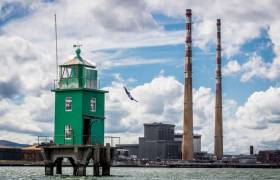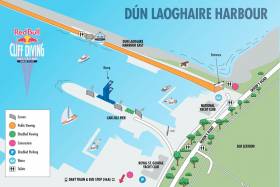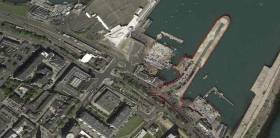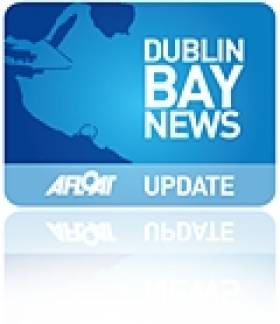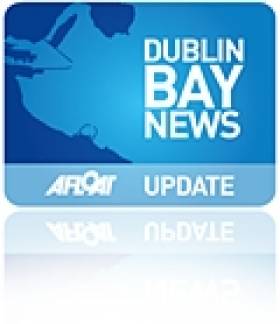Displaying items by tag: Carlisle Pier
The Red Bull Cliff Diving World Series makes its long-awaited debut in Dublin this afternoon (Saturday 11) with events kicking off at Dun Laoghaire’s Carlisle Pier at 5pm.
As previously reported on Afloat.ie, entry is now free for the two-day competition but organisers have advised everyone attending to arrive early to ensure a spot to witness the action.
Big numbers will be expected at the waterfront to see reigning champions Gary Hunt and Rhiannan Iffland continue their domination of the rankings after last month’s opening round in the Philippines.
Tomorrow’s finals (Sunday 12 May) will be broadcast live on Red Bull’s website, YouTube and Facebook from 7pm.
This weekend is not the first time Ireland has hosted the Red Bull cliff divers, who’ve previously made a splash on Inis Mór in the Aran Islands.
Red Bull Cliff Divers To Wow Crowds In Dun Laoghaire Next Month
“Unforeseen circumstances” have prompted the move of Dublin’s leg of the 2019 Red Bull Cliff Diving World Series from Grand Canal Dock to Dun Laoghaire Harbour.
But Dublin city centre’ loss is Dun Laoghaire’s gain — even more so now that the event will have free entry over the weekend of Saturday 11 and Sunday 12 May.
Bigger event space at Carlisle Pier on Dun Laoghaire’s waterfront will mean even more fans will be able to attend what promises to be a fun weekend out for all the family.
Both Saturday and Sunday events will kick off at 5pm, however organisers advise everyone to arrive early. The Sunday event will feature the Irish finals and will be broadcasted live on Red Bull’s website, YouTube and Facebook from 7pm.
Those who already purchased tickets for the Grand Canal Square event have been contacted for refunds.
Dublin is hosting the second leg of this year’s cliff diving series, which makes its debut in the capital after three previous visits to Inis Mór in the Aran Island, the most recent two years ago.
Dun Laoghaire Harbour's Carlisle Pier 'Regeneration Plan' Seeks Expression of Interest
Dún Laoghaire Harbour Company is considering how best to proceed with the regeneration of the Carlisle Pier, a major leisure and cultural site that is located between the National Yacht Club and Royal St. George Yacht Club.
The pier is regularly used by both yacht clubs during major internatonal sailing events staged at the port for the the storage of competition boats for the course of a regatta, such as the recent Laser Radial World Championships.
It is currently in use as a car park and short–term berth for shipping for the unloading of some unusual cargoes and also a berth for cruise ships.
The Company now wants to gauge market interest in what it deems a 'significant opportunity'. According to planning guidelines, any development of the site should regenerate and enliven the waterfront, be sensitive to the setting and should include a significant portion of cultural and amenity uses, with public accessibility and permeability to the waterfront paramount.
The National Ports Policy suggests that Dun Laoghaire Harbour will position itself as an exciting marine leisure tourism destination of international calibre; one which elegantly integrates the local town with an historic 200-year old harbour, and which offers a striking blend of modern amenities mixed with a traditional marine ambience in a Dublin Bay setting, making it one of the most beautiful man-made harbours in the world.
The harbour is located in the busy town of Dún Laoghaire, which has two shopping centres along with a great range of restaurants, boutique shops, theatres, a magnificent new library and parks. Key to the town’s attraction is its transport links, DART station and key bus routes.
The N11, M50 and QBC’s provide convenient access to the city (5 miles) and surrounding suburbs. Many well-regarded primary, secondary schools and third level institutions are just a short distance away.
The Dun Laoghaire Harbour Masterplan proposes the regeneration of this major leisure and cultural site on the historic Carlisle Pier. This regeneration initiative could involve approximately 8,000m2 of space in a high amenity / high activity, publicly accessible environment.
The pier and associated lands are in temporary uses and circa 1.1 hectare historic waterfront site is available for imaginative proposals subject to planning.
Planning
Carlisle Pier is zoned Objective W in the County Development Plan 2016 – 2022. Objective W permits a broad range of regeneration combinations. Special Local Objective 16 relates specifically to Carlisle Pier and emphasises the cultural and amenity aspect of any future regeneration of this historic site.
For more details download the Market Consultation Regeneration notice below
Dun Laoghaire Makes Case Abroad For Diaspora Centre
#DunLaoghaire - Dun Laoghaire Harbour Company chief executive Gerry Dunne made the case for a diapora centre in the South Dublin port town at a gathering in the House of Lords in London recently.
The meeting was hosted by Baroness Detta O’Cathain, a member of the leadership council of the Irish International Diaspora Trust which is working to create a diaspora centre at Dún Laoghaire Harbour.
In an opinion piece published in The Irish Times a few weeks ago, Baroness O'Cathain wrote that "by supporting the creation of a disapora centre... we will be paying tribute to our ancestors."
The proposed Irish International Diaspora Centre forms part of the Masterplan for Dun Laoghaire Harbour, which will involve an investment of more than €230 million over the next 10-15 years.
The €50 million diaspora visitor centre envisaged for Carlisle Pier would celebrate the “origins, diversity and influence of the Irish at home and abroad” at a place where thousands of Irish people left for new lives in Britain and beyond in decades past.
Baroness O'Cathain said she was pleased that the Programme for Government "seeks to support the creation of a diaspora centre", adding that "we must pass on to this generation and to future generations the importance of the Irish DNA of the soul.
"The sense of belonging to a very precious country brightens our lives. This is what, in strong terms, the diaspora centre will do."
Last summer The Irish Times reported that Peter Whittaker of Martello Media was been appointed creative director of the Irish International Diaspora Centre development team.
Dun Laoghaire Harbour's Sunday 'Family-Funday'
Opening times are 11am to 5pm and the entry fee is €3 for adults and children go free. The Funday is to help raise funds to support the local national maritime museum of Ireland in Dun Laoghaire. The Maritime Institute of Ireland is a registered charity, which run the museum through volunteers. In addition they host lectures, represent maritime interests and operate a museum and library.
The museum is housed in the former Mariners Church and is currently closed due to renovation and improvement works. There will be a 'soft launch' or 'preview' of the museum from October to mark the M.I.I.'s 70th anniversary.
Next year the museum is due to be officially re-opened during the Easter. The M.I.I. welcomes new members, volunteers and donations. For further information visit www.mariner.ie
- Pirates
- Carlisle Pier
- Dublin Bay News
- Maritime Institute of Ireland
- Dun Laoghaire Harbour
- M.I.I.
- Mariners Church Dun Laoghaire
- Dun Laoghaire Harbour News
- Irish maritime museums
- Family Funday
- DART Dun Laoghaire
- DART railway
- Pirats and Princesses competition
- Irish maritime interests
- Irish maritime lectures
- Irish maritime library
- National Maritime Museum of Ireland
- NMMI
Boat Jumbles for Dun Laoghaire, Howth and Carrickfergus
If you fancy a rummage through a Bosun's locker then boat Jumble sales on three consecutive weekends and at three separate locations will satisfy all bargain hunters when the Irish boating season kicks off in a fortnight's time.
Each show is offering a range of boating, sailing and water sports equipment and accessories. There are new and used pitches and some familiar trade names in addition to second hand boats/dinghies and nautical “car boot” items.
The first opens on March 27th – the weekend when the clocks go forward – and it takes place on the Carlisle Pier in Dun Laoghaire Harbour from 10am to 4pm.
The next is across Dublin Bay when the RNLI stage a boat jumble at Howth Yacht Club on Saturday 2nd April from 10.30am to 1.30pm.
The last show is at Carrickfergus on Belfast Lough and this 'Irish Boat Jumble' is being promoted as the 'biggest' in Ireland. The Antrim show will be on Sunday 10th April starting at 10am.
All are offering economical rates and friends are being encouraged to team up and pool their surplus gear and share the selling task!
Green Party Speaks Out for Small Boat Owners in Dun Laoghaire
Ciaran Cuffe TD of the Green Party has spoken out in support of small boat owners in a submission to the Dún Laoghaire Harbour Masterplan. Cuffe, a candidate in the General Election, says the prioritisation of space within the harbour for surface car parking and marshalling yards for ferry services has reduced the space available for small boat owners. Cuffe says the masterplan should specifically enhance facilities and storage space for small boat owners, such as the Coal Harbour Users Group (CHUG) and local yacht and water sports clubs. He also says consideration should be given to the development of workshops to promote traditional boat building and small craftrepair and restoration.
The full submission from Ciaran Cuffe is below:
"I welcome the preparation by the Dún Laoghaire Harbour of a masterplan for the harbour area. Dún Laoghaire harbour is a major recreational and amenity resource for the locality andwider Dún Laoghaire area and a long-term strategic vision underpinned by a plan-ledimplementation framework is vital in order to secure the harbour's future for the benefit of both the Harbour Company and the local community.
Maintaining a ferry link to the UK
I welcome the proposal to redefine Dún Laoghaire Harbour as a leisure harbour. However, Ibelieve that future opportunities to keep a ferry link with the UK should not be lost. As we have seen during recent incidents when airplanes were grounded, travelling by ferry is still aviable means of travel and may become increasingly so in the future. A seasonally ferryduring the summer months could be considered and the infrastructure needed for a ferryservice should be maintained. The Harbour Company should work to secure INTERREG funding to provide better linked-in ferry and train services between Ireland and the UK.
Cruise Ships & Tourist Development
There is considerable scope to attract the cruise liner market to Dún Laoghaire. Dún Laoghaire is a fantastic harbour location with a unique built and natural heritage. Its location immediately adjacent to the Dún Laoghaire DART station makes it an ideal gateway locationfor tourists to explore Dublin City and hinterland. We have seen the positive impact of large cruise liners docking at Dublin Port with thousands of visitors disembarking, visiting Dublin's tourist attractions and spending money in local businesses. Dún Laoghaire Harbours offers a much more pleasant and suitable docking location for cruiseships and there is a major opportunity to exploit this economic potential for the benefit of the wider locality. Any physical works required to facilitate the mooring of large cruise liners in Dún Laoghaire should be carefully designed so as to avoid any adverse impact on local builtand natural heritage, including the Dublin Bay Special Area of Conservation.
Built Heritage
The unique physical fabric and built heritage Dún Laoghaire Harbour is an important assetand must be conserved and enhanced. In particular, the historic Carlisle Pier now has thepotential to provide a high quality outdoor public amenity space. I understand that elements of the 1890's Victorian railway building have been retained and I believe that these elements should be reconstituted as part of multi-functional covered space to, for example, host an ice-rink in winter, the Festival of World Cultures in summer and occasional outdoor events andmarkets.
Open Space & Public Accessibility
In recent years significant areas of the Harbour Company land was converted to revenuegenerating surface car parking. This has created a car dominated environment and adisconnect between the harbour area and Dún Laoghaire town. The long-term future of theharbour is much better served by opening up the harbour area to pedestrians and cyclists, enhancing accessibility for the general public, improve directional signage, reducing surfacecar parking and delivering more green spaces. In order to achieve this, the Masterplan shouldinclude a detailed design framework for the public realm including further measures to removethe barriers to accessibility due to the rail line.
Views
The sensitive built, natural and visual environment of the harbour requires a very carefulapproach to any future infill development. Particularly, infill development should be in keepingwith the existing building heights of the town to protect the harbour setting and views fromDún Laoghaire to Dublin Bay and Howth Head and sensitively designed to conserve thecharacter of local built heritage and the numerous important protected structures.
Small Boat Owners
The prioritisation of space within the harbour for surface car parking and marshalling yards for ferry services has reduced the space available for small boat owners. The masterplan should specifically enhance facilities and storage space for small boat owners, such as the CoalHarbour Users Group (CHUG) and local yacht and water sports clubs. Consideration should be given to the development of workshops to promote traditional boat building and small craftrepair and restoration.
Conclusion
Dún Laoghaire is extremely fortunate to have a unique historic harbour resource, which is a central part of the local identity and a much loved and valued social, recreational, and amenity resource. However, the future economic viability of the harbour is dependent on creating appropriate synergies with the wider economy of Dún Laoghaire. The imaginative redevelopment of the harbour can contribute significantly to the local economy, particularly inthe development of heritage and tourism initiatives, The Masterplan must focus on how the future development of the harbour can contribute to cultivating these synergies in a manner, which is economically, socially and environmentally sustainable."
Dun Laoghaire Plans to Welcome 'Next Generation' Liners
A new masterplan to make Dun Laoghaire a port of call for the cruise liners of the future is on the cards, according to The Irish Times.
Gerry Dunne, chief executive of the Dun Laoghaire Harbour Company, said Ireland's east coast is in need of a facility to cater for cruise ships of the size currently being built.
Plans would involve excavating the harbour to a depth of 9.5 metres and building longer berths to accommodate ships that will reach more than 300 metres in length
Dunne said Dun Laoghaire needed to think about its future as the harbour's "lucrative contract" with Stena for its high-speed ferry service is due to expire in April.
The plans are supported by Dun Laoghaire-Rathdown County Council and the local chamber of commerce. No details of costs or funding of the project have yet been made available. The Irish Times has more on the story HERE.
As previously reported on Afloat.ie, the Dun Laoghaire Harbour Company has issued an invitation to tender for a new floating berth for cruise liners despite being refused permission to continue development of the Carlisle Pier site.
Plans For Pontoon Berth Despite Block on Carlisle Pier Development
The Dun Laoghaire Harbour company has issued an invitation to tender for a new floating berth, despite being refused permission to continue development of the historic Carlisle Pier, The Sunday Business Post reports.
Most of the listed structure was torn down in September 2009 and replaced with a car park by the company, which said it received legal advice that planning permission was not required.
Following a campaign by local residents and the intervention of Green Party TD Ciarán Cuffe and Dun Laoughaire Rathdown County Council, An Bord Pleanála ruled that the redevelopment was not exempted.
According to The Sunday Tribune, the development plans were rejected on the basis of their effect on the local conservation area and failure to reuse elements of the old pier structures.
However, last week the company published a notice inviting tenders for a floating pontoon berth to be attached to the old pier, designed to accommodate cruise passengers.
The tender details are available to read online, and the project is currently pending planning permission.
The harbour company is part of the Dun Laoghaire Cruise Stakeholder Group, which is marketing the town as a destination for international cruise liners.
Dun Laoghaire ‘Cruise’ Harbour Project Out To Tender
-Dun Laoghaire Rathdown County Council
-Dun Laoghaire Harbour Company
-Dun Laoghaire Chamber of Commerce
-Dun Laoghaire Business Association
and Dun Laoghaire Tourism interests.



























